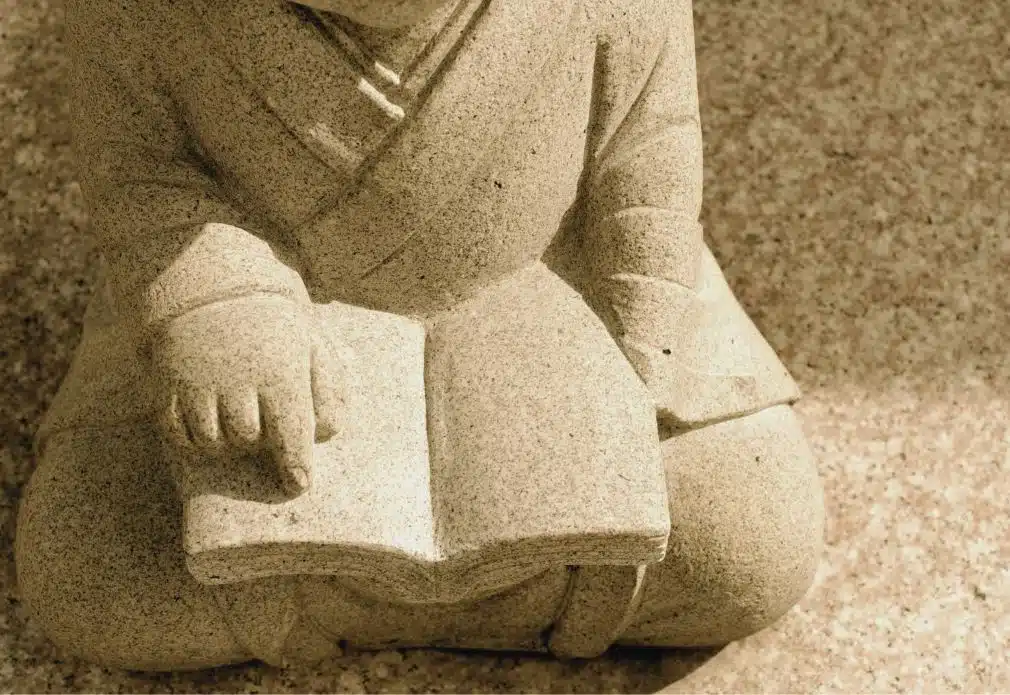In the Translator’s Workinghouse 6

Written By Paul Baffier
Blog | Culture and tradition | Reflections on translation
In “In the Translators Workinghouse 6”, Paul explains that all spiritual practice is based on intellectual erudition and yogic realization.
In the translator’s workinghouse 6
Kedrup: The learned and the accomplished
One day, Lama Kunsang [1] spoke to us about the difference between the learned and the accomplished, a difference that extends to the way in which the same term is translated. In the tradition, this difference is identified by the term “Kedrup”, a compound word meaning “scholar” (Tib.: mkhas) and “accomplished” (Tib.: grub). It’s a term we come across a lot in the texts, and like all terms that are used a lot, we might think it’s anodyne; whereas on the contrary, the tradition insists, insists, and insists again on telling us something fundamental.
This is that all spiritual practice is based on two aspects, two dimensions of the path which, when properly balanced, respond to each other and complement each other: intellectual erudition and yogic accomplishment; erudition is based on knowledge of the texts and know-how of the tradition and accomplishment is based on the stable and complete fulfillment of the experience of the nature of the mind; for our spiritual path, these are the two legs with which to walk; if one or the other is missing, bang! We stumble, unable to move forward.
“The advantage of the Dzogchen tradition is that it is extremely well marked out, structured and ‘mapped’: experiences, both provisional and definitive, are referenced.”
The advantage of the Dzogchen tradition is that it is extremely well marked out, structured and ‘mapped’: experiences, both provisional and definitive, are referenced. Referenced, they are identifiable and can be found on our path. We can then classify and categorize them, without making a mountain out of a molehill of them, without raving about them, without thinking we’ve arrived: just noting them on the wonderful map of possible experiences that is not the end of the road.
Knowledge, of the texts that unfold all the dimensions of the path is therefore absolutely essential. Pushed to the limit, this knowledge produces the scholar, whose excellence is useful to all, since each person can draw at will from this living library to find the resources he needs to elucidate his own experience. Like a gushing spring, the scholar will pour forth the flood of definitions and terminologies to quench the aridity of our misunderstandings and doubts.
But this unstoppable rain of erudition, carrying the torrent of pure words marked by the seal of non-dual compassion of the masters of the past – who, experiencing the sharp intensity of the sovereign heart, left this legacy of explanations and apophthegmata, these humble and immense accounts of life – must not make us forget that what is understood intellectually must be put into practice. What has been glimpsed must be stabilized, by taking the time to do so.
This is the intrinsic knowledge of yogis, who, seized by this fundamental command, have dedicated their lives to this imperative: to bring to fruition the introduction to the nature of mind. This practical genius, this white-hot intensity, this fervor that must nevertheless endure the long time of repeated training, places yogis in the category of the “accomplished” (Tib.: grub), those who cultivate their experience to its ultimate, non-dual unfolding, beyond words and concepts. Boredom and enthusiasm, obstacles and difficulties, all the vagaries of the mind, will form the non-dual equality of the Dzogchen yogi who, having transcended the ideas of progress and error through repeated effort, becomes the bearer of the limitless clarity of primordial self-evidence.

Lama Kunsang explains that, from the translator’s point of view, there will always be two ways of translating: the scholarly way and the yogic way. These two aspects must be harmonized to produce a Dzogchen translation that satisfies both our need for experience and our need for mental definition. The translated term must be able both to determine the appropriate characteristics of the experience and to awaken us to what it really is, without the filter of reason or literary aesthetics interfering with the living readability of Dzogchen terminology. From the perspective of the oral lineage, every term is actually a man ngag – a direct instruction – given by the Dzogchen master to the disciple, pointing to the required experience.
The words of Dzogchen are therefore to be treated with great respect and special care: for they reflect the empty essence and its dynamic activity… which are manifest in everyone. The union of the scholar and the yogi is therefore essential for the sharpness of the translations. Lama Kunsang reminds us that a translator who has not practiced a teaching lineage will not be able to bring out the variations in meaning that bring out the profound meaning of the specific instructions of each lineage, which is their idiosyncrasy, their spice. We must therefore be wary of our Western tendency to translate the meaning without having any idea of what the experience really is. The term ‘Kedrup’ is therefore a reminder of this subtle balance.

[1] Under the spiritual authority of the first Kalu Rinpoche and Bokar Rinpoche, Lama Kunsang completed the traditional three-year meditation retreat, followed by a further one-year retreat. He then spent five years living in a monastery in the Himalayas, working as a member of the international committee of translators set up by Kalu Rinpoche to translate the ten-volume encyclopaedia of Buddhism, The Treasury of Knowledge (Tibetan: ‘Sheja Kunkyab Dzö’), which today serves as a reference work in the Buddhist world. Lama Kunsang is co-author of “L’Odyssée des Karmapas, la grande histoire des lamas à la coiffe noire”, published by Albin Michel. BACK
More Posts
Starlight
In "Starlight", Mila Khyentse talks about winter nights, starlight and light of mind. We just have to look up!
The Tibetan Transmission: the Transmission According to the Four Initiations of Vajrayana
The Tibetan transmission, according to the four initiations of Vajrayana, leads to the complete realization of the ultimate nature of all reality.
The ground of all Künshi
This article “The ground of all, Künshi” provide a better understanding of the essential words and concepts of Dzogchen.




